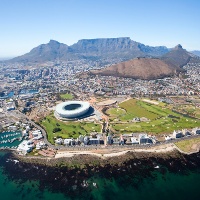Table Mountain
The Western Cape is known for its vibrant port city of Cape Town, aka the Mother City, set beneath Table Mountain. Table Mountain is part of the peninsula chain of mountains that stretches from north to the south. The mountain is regarded as one of the world’s natural wonders. It was previously known as the Hoerikwaggo (mountain in the sea) by the Khoisan people of the Cape, and it offers an array of activities to visitors, ranging from the 1,086-metre cableway ride and the challenging route of Platteklip Gorge to a stroll through the green landscape below. The mountain not only makes for a great view of the city below, it also boasts a beautiful range of flora as part of the Cape Floristic Kingdom. Once on top of the mountain you can get a free guided tour from Cableway; the tours take place at 10h00 every morning and in the afternoon. The tour paths cover two kilometres starting at the Upper Cable Station.
Cape Wine Route
The Western Cape’s wine farms are a big attraction. You can experience restored Cape Dutch farmsteads and, if you are lucky, a free wine tasting. Or indulge in views of the vineyards stretching from the coast to the Little Karoo. The route offers some 560 wineries and 4,400 primary producers of vineyards in the Cape. For a laidback experience visit the Steenberg Vineyards. Established in 1682, it offers more than just wine and a tour; the farm’s free tasting includes six wines from the Premium and Super Premium ranges.
Museums
A trip to Cape Town is not complete until you take a boat to tour Robben Island. The notorious prison that held South Africa’s former president Nelson Mandela for 27 years is now a living museum. The island is a South African National Heritage site and also a UNESCO world Heritage site. The District Six Museum was established in 1994 and serves as a portal back to the Apartheid era, unfolding the history of the once vibrant district. District Six was named as the sixth municipal district of Cape Town in 1867; the area consisted of a mixed community of freed slaves. The people were forcefully removed in 1901 and the area became whites-only by 11 February 1966. The Stellenbosch Museum is a great place to get a look at old-model houses. The museum has four houses of historic interest. The Schreuderhuis represents the period of 1680 to 1720. It was built in 1709 and was the first to be restored after the first great fire in Stellenbosch. The Blettermanhuis is the second home in the museum complex and was built in 1789 by the town’s last magistrate appointed by the Dutch East India Company, Hendrick Lodewyk Bletterman. It depicts a wealthy Stellenbosch home from 1750 to 1790. The Grosvenor house was built in 1782 and holds the characteristics of the 19th century, representing the period of 1800 to 1830. The fourth and last house is the O.M. Berghhuis, and it represents the period of 1850-1870. O.M. Bergh lived with his family in the house for 41 years.
Nature Lovers
The province more than caters for nature lovers. The Western Cape is home to many nature reserves. The Wilderness National Park is one of them, nestled between rivers, lakes and beaches, and is nothing short of a work of art along the Garden Route. The park comes to life during spring when a blanket of colourful flora can be seen. The Wilderness National Park protects three major areas of indigenous forest, four types of Fynbos (wild shrubs), lakes and winding waterways. If game drives and horse riding tickle your fancy, the Plettenberg Bay Game Reserve is just the place for you. The reserve offers professional game activities, horseback safaris and cultural tours. It also provides the convenience of accommodation at the Baroness Lodge, with six double rooms and three family rooms as well as one twin room. The Wilderness National Park has a variety of wildlife and over 100 bird species.
Victoria & Alfred Waterfront
Tone it down a bit and unwind at the splendid Victoria & Alfred Waterfront (V & A Waterfront) at the harbour, ideal for those looking to experience all of Cape Town under one roof. The 123-hectares house a complex of 450 retail stores for those wishing to splash out. The complex is still an active harbour with boats delivering fresh fish and offers, among many other things, the Springbok Museum.

